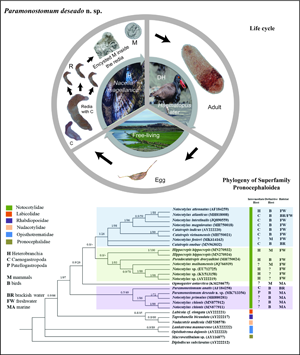Article contents
Paramonostomum deseado n. sp. (Digenea: Notocotylidae) parasitizing the South American Black Oystercatcher and their atypical life cycle from the Patagonian coast
Published online by Cambridge University Press: 17 August 2022
Abstract

By way of morphological and molecular analysis we describe a new species of notocotylid, Paramonostomum deseado n. sp., parasitizing Haematopus ater from Argentina and we contribute to elucidate its life cycle. Within this genus, 4 groups can be morphologically distinguished according to body shape: ‘Oval’, ‘Pyriform’, ‘Elongate’, ‘Overlong’. The new species belongs to the ‘Elongate group’, which presents a wide variation in body length (597–4500 μm). The new species, Paramonostomum caeci from Australia, Paramonostomum actitidis from the Caribbean and Paramonostomum alveoelongatum from Russia share the smallest range of body size in this group (<1130 μm). The new species more closely resembles P. actitidis but differs from it by cirrus-sac length, which is shorter in the new species (97–146 vs 280–430 μm in P. actitidis), and egg size which is larger in the new species (25–33 vs 18–20 μm in P. actitidis). Paramonostomum deseado n. sp. uses the limpet Nacella magellanica as both first and second intermediate hosts in which metacercariae encyst inside the redia. This is the first abbreviated cycle described for notocotylid species. Ribosomal RNA sequences provided for adults (ITS1, ITS2 and 28S) and metacercariae inside the rediae (ITS1) support the species identification and the correspondence among stages. Phylogenetic analysis based on 28S placed P. deseado n. sp. close to other Notocotylus spp. and Paramonostomum anatis. Molecular results demonstrate that the hosts involved in the life cycles and the habitat more than morphological differences are determining the phylogenetic relationships in members of Notocotylidae.
Keywords
- Type
- Research Article
- Information
- Copyright
- Copyright © The Author(s), 2022. Published by Cambridge University Press
References
- 1
- Cited by





